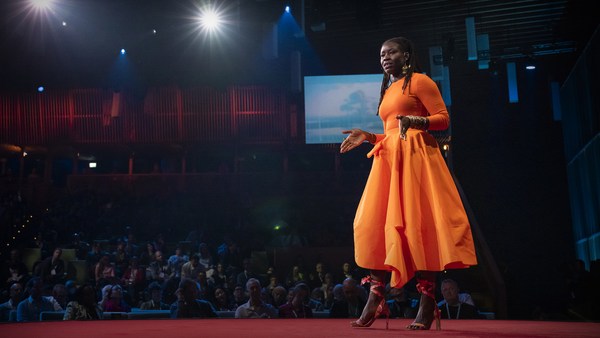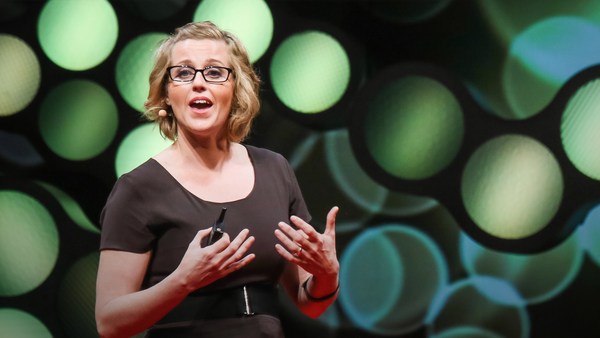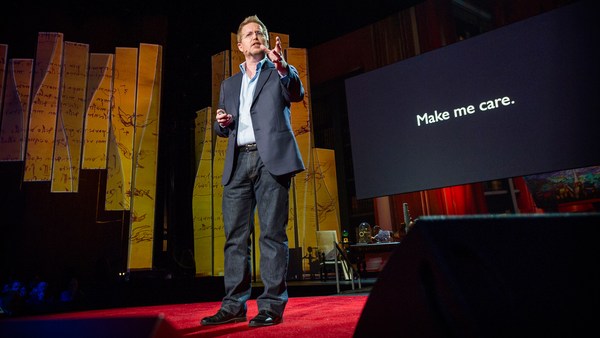We're here today to hear compelling ideas, new innovations and thinking in science and medicine. And innovative solutions to our most vexing problems in society. So they said to me, "Eric, do you have anything that you can add to this compelling list of stories and ideas? Something you can talk about here on the TED stage?"
And I said, "Of course I do." And the question I want to explore with you today is: Why don’t vampires cast reflections in mirrors?
(Laughter)
So, you've probably seen this before in movies. The humans are suspicious of the new dark stranger, and they band together in this moment of confrontation, and they open up a mirror in front of them and bam -- there’s no reflection there. Proving to the humans that the new dark stranger is, in fact, a vampire. That's right.
So where did this start? How did this happen? This idea that you could hold a mirror up to an undead creature and learn that they are a vampire? Well, we're going to find that out. The thing you have to keep in mind is, as we look through the history of vampires, that they change over time. Every culture in history has had a variation on a vampire. Every single one. Very few of them use -- Are you laughing at some of these illustrations? Maybe you are. I did sneak one in there. So they don't always call them vampires. But every culture has a version of a supernatural creature who comes back from the dead and gains power by preying on the living.
Our version of the vampire really came about in the 16th century. It was a way to conveniently explain some misunderstandings about death and dying. Some sketchy activity happens in the village. Someone gets an idea, "Hey, let's dig up Wolfgang." And they opened his coffin, and they find that his hair and his fingernails and his teeth have all seemed to grow since he died. And they see some fluid around his mouth which they mistakenly think is blood. Proof that Wolfgang is a vampire. But this is actually what happens to a body when it's decomposing. Not that they're undead. Our understanding of vampires really exploded, or our lexicon for vampires really exploded in the 18th century after a rabies outbreak in Hungary and Romania. Now, the thing to remember is that when a human contracts rabies, it can take a couple weeks before symptoms start to manifest. So some really common vampire characteristics, like an avoidance of bright lights or strong smells like garlic, an aversion to water and suddenly aggressive behavior are not signs of the undead. They are signs of rabies. But back then, they couldn't put those things together. They didn't think that the neighbor who's acting funny now, it wasn't because of the raccoon that bit them two weeks ago. It's because now a much more logical explanation is that they are, in fact, a vampire.
(Laughter)
So most of our ideas of vampires that we all think of came about in the movies. Count Dracula and Sherlock Holmes have been in a decades-long battle to be the most depicted fictional character in film. It goes back and forth every couple of years. But when we think of the vampire in film, there are some things that are quite iconic to us, like "Nosferatu," right? Here's a fun fact for you about "Nosferatu." Outside of that, most people get something wrong, they think it's the first vampire movie. It wasn't, but it was the first one that was anything like approaching a hit. The fun fact I want to share with you is that every copy of "Nosferatu" that any of us have ever seen is an illegal bootleg. Bram Stoker’s widow, sued the filmmakers for copyright infringement. She was worried that "Nosferatu" was going to cut into the quite lucrative royalties from the stage version of "Dracula" that was being performed in the UK and the US. She won that lawsuit, and in her settlement, she demanded that every copy of the film be destroyed.
Most people, when they think of vampires, think of the 1931 Tod Browning classic starring Bela Lugosi as Count Dracula. You almost can't overstate how huge a movie this was. It not only really established vampire movies, it started a vampire movie trend that lasted for over two decades. It was the first mainstream hit that was a horror film. It really established horror as a genre in film and set up expectations for, like, even “Frankenstein,” that came later that same year.
Since this whole craze of vampires really started with Dracula, we've had so many, hundreds of variations on the vampire. We have had samurai vampire, we have had plumber vampires, we have had vampire babies, we have had stripper vampires. We've had a vampire movie about every member of Dracula's extended family. Son of Dracula, daughter of Dracula, father of Dracula, bride of Dracula. We've even had Dracula's dog in "Zoltan, Hound of Dracula."
(Laughter)
There is one definitive thing I can tell you about vampire movies, and that is, vampire movies suck.
(Laughter)
And I'm not being metaphorical here. Vampire movies are not good movies.
(Laughter)
So why is this? Why is it that these movies don't really last very long? It's because we keep changing our idea of what terrifies us and what scares us.
You know, speaking of things in common, there's one thing that vampire movies do not have in common. Does anyone want to guess what vampire movies do not have in common? Vampires. It became such a hot trend for vampire movies that people would slip the word vampire into the title, even though there wasn't a vampire in the movie. There's multiple ones of these. The the most notorious of these was the 1952 stinker called "My Son the Vampire," which did star a late-career Bela Lugosi. But he didn't play a vampire, and no one else in the cast did either. But they figured it would be a big trend and get in on a big trend and did this. So not even this happened.
I often get asked, what is the best vampire movie I've ever seen and the worst vampire movie I've ever seen? And it may surprise you to learn that the best vampire movie I've ever seen, and the worst vampire movie I've ever seen are the same film.
(Laughter)
"Jesus Christ, Vampire Hunter."
(Laughter)
So we know a lot about Jesus, right? But somehow history has forgotten that Jesus of Nazareth is apparently also a kung fu master.
(Laughter)
And in this movie, Jesus comes back to Earth to save the world and humanity from a vampire cult who has taken over. And he uses his kung fu skills to do this. And one more little tidbit, "Jesus Christ, Vampire Hunter" is also a musical.
(Laughter)
So, just for your enjoyment, I did bring along the trailer to this great piece of cinema.
(Video) In the new millennium, vampires no longer fear the sun. Now they're going to learn it's time to fear the Son of God.
(Music) Live to fight. Right to live. Live to fight. Right to live. Phil Caracas is "Jesus Christ, Vampire Hunter."
(Applause)
I am assuming that you're all in some state of stun after seeing that. So let me give you a real quick recap of what you saw. You saw Jesus riding a Vespa, then you saw Jesus getting his hair cut, then you saw Jesus kicking some holy ass. And you also saw El Santo, the famed Mexican masked wrestler, who is in the film and plays Jesus's sidekick.
So I think we've established over the last several minutes that there are many colors in the vampire rainbow. So let's not get too far away from our original point. Why don't vampires, in all these bad films, bad novels, bad stories, why do none of them ever cast reflections in mirrors? I mean, there are not one but several vampire tales where the vampires are deathly scared of uncooked rice. Yeah, true. Count von Count from "Sesame Street" is based off of the idea that vampires are obsessed with counting. And if they see sand or rice on the ground, they're going to have to stop and count every grain, the sun comes up and they die. There you go. A little improvised little bit for you right there.
So now see if I can find my place back into what I'm talking about. So if you want the answers to why they don't cast reflections in mirrors, the answer is that there really isn't a clear answer to this question. The consensus thinking is that when you hold -- it comes from the habit or something people did of holding a mirror up to a deceased person's face to see if the warm breath would fog up the mirror. And if you think about it, if someone's lying prone and you hold a mirror up to their face, what you're going to see in that mirror is the wall. You're not going to see them. Therefore no reflection in the mirror. But I think there's actually a far simpler answer than this. When you look at vampires and how they change over time, what was once terrifying and evil becomes dull and campy. We change the vampire to match our time.
In the 1890s, Bram Stoker's "Dracula," the novel, was thought to be an allegory for the end of Victorian morals. In 1931, when "The Dracula," starring Bela Lugosi, came out, the idea was that that represented a fear of eastern European immigration. In the 1950s, vampire films represented a fear of communism. We morph the vampire to match our time.
So with this, why don't vampires cast reflections in mirrors? I think it's because the vampire is the reflection. They are a reflection of us. They are a reflection of what we fear. They are a reflection of what we consider to be unchecked power without accountability. They are our idea of the ultimate villain that lies almost undetectable, until someone holds a mirror up to them.
All our talks today are themed around unity, the idea that when we come together, we are stronger. I would argue that it's not only about the things that we share in common as far as beliefs and things that we believe, but also the darker things that unite us. When I know what you fear, when I know what goes bump in your night, perhaps I can help protect you. Perhaps we can help protect each other. There are so many vampires in the world today. Vampire. Vampire. Vampire. (Laughter) Vampire. Vampire. Vampire. Vampire. Vampire. Vampire.
So when I originally put this talk together, there was a picture here. And the TEDx people said, "Maybe you should take that picture of a politician out."
(Laughter)
And I will leave it to you to figure out what politician's picture I just might have put in there in a list of vampires. Maybe better yet, I could ask what politician wouldn't be put in a list of vampires?
But I want to leave you with this. One thing that I see in so many vampire stories is the thing that brings about the monster's decline is when the humans, who are weak and powerless individually, come together and unite, and they prevail. It's a concept called unity.
(Applause)





